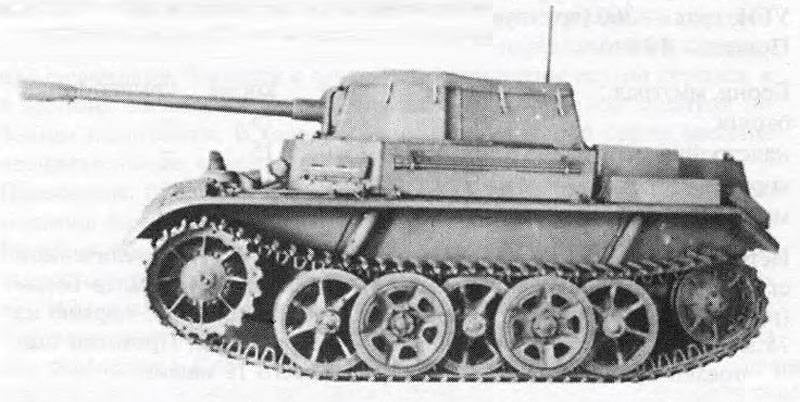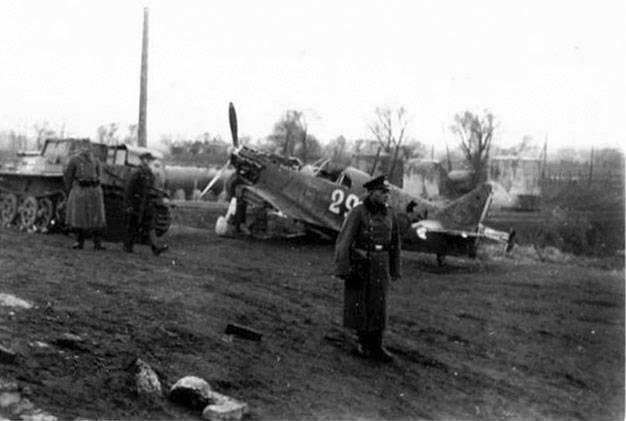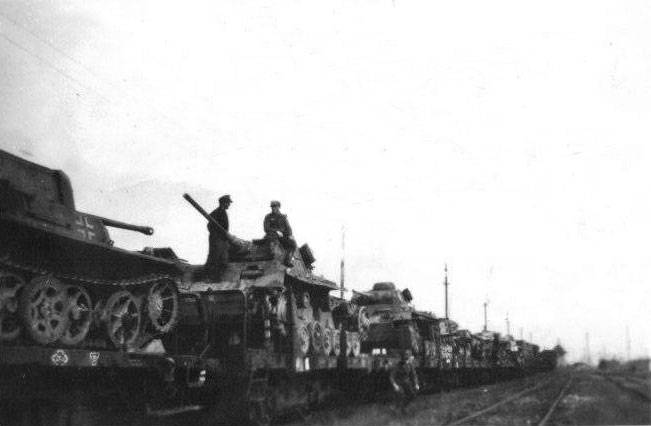Self-propelled artillery unit Panzer Selbstfahrlafette Ic (Germany)
A preliminary study of the project of a new self-propelled artillery self-propelled gun began in July 1940. By this time, the VK 901 tank passed part of the tests and managed to show insufficiently high performance. For example, a potential customer in the face of the Wehrmacht command was not satisfied with an insufficiently powerful booking, because of which the car could not fully solve the “tank” tasks. At the same time, the existing tracked chassis was of some interest and could be used in other projects.
According to the results of brief discussions, it was decided to develop a new self-propelled artillery installation based on the existing light reconnaissance tank. A promising project received the designation Panzer Selbstfahrlafette Ic ("Armored self-propelled gun carriage"). In addition, 5cm PaK 38 auf Pz.Kpfw.II Sonderfahrgestell 901 is known to be applied to this development. Also, in some sources, light ACS is designated as VK 903b and indicates that it was a development of the VK 903 tank, and not the VK 901. Nevertheless, this version looks implausible and contradicts other data about the project.

General view of the self-propelled gun Pz.Sfl.Ic
According to reports, the development of a new ACS Panzer Selbstfahrlafette Ic or Pz.Sfl.Ic was entrusted to Rheinmetall-Borzig. The basic design of the light tank was created jointly by Daimler-Benz and MAN, but development was entrusted to another organization. It should be noted that the creators of the VK 901 tank also did not remain without work: at that time they were engaged in a number of other projects, including the updating of the existing reconnaissance vehicle.
The basis for the new ACS was to become the existing light tank, the design of which required a number of changes. All improvements, in the first place, were associated with the need to install new weapons. In addition, according to some data, some units of the chassis were modified, which was done to improve performance in comparison with the base tank. As a result of this approach to design, an armored vehicle turned out to look like the base tank VK 901. At the same time, there were noticeable external differences.
Perspective self-propelled gun Pz.Sfl.Ic as a whole retained the hull and chassis of the base tank, although some units have undergone changes. Old remained the overall architecture, layout and protection of the body. Thus, the chassis for the ACS was still proposed to be built according to the classic German armored vehicle scheme with a front-mounted powertrain and driver, central combat compartment and aft engine compartment. It was proposed to modify the fighting compartment in order to install a new armored unit and the required weapons.
The existing hull shape was retained with several 30-mm front sheets located at different angles to the vertical. The hull sides and stern were 15 mm thick. Some sources, however, argue that the new project decided to strengthen the booking by replacing 15-mm sheets with 20 mm-thick parts. The machine was protected from above and below by a roof and a bottom no thicker than 15-20 mm. The armored body received a frontal part of a complex shape, and was also equipped with a developed under-the-box box on which it was proposed to mount new units of the fighting compartment.
The Maybach HL 66P carburetor engine with 150 horsepower was saved in the stern. The composition of the transmission also remained the same. The task of the manual transmission with a five-speed gearbox was to drive the front drive wheels. As with many samples of German armored vehicles of the time, the main part of the transmission units was located in the front of the hull and connected to the engine with a propeller shaft passing over the bottom.
The overall architecture of the base tank chassis was retained. According to some information, during the development of self-propelled guns, it was decided to strengthen the suspension, which could be associated with the use of more powerful tools. Also, there are data on the processing of the VK 901 tank chassis, taking into account the developments of the VK 903 project, as well as using its aggregates.
The overall design of the undercarriage of the ACS Panzer Selbstfahrlafette Ic did not differ from VK 901 and VK 903. The chess arrangement of the five support rollers on each side was used (two in the outer row and three in the inner). The rollers received an individual torsion bar suspension. Relatively large drive wheels were placed in the front of the hull with a significant excess over the rollers, the guide wheels of a smaller diameter - in the stern. The upper branch of the small-track caterpillar was supposed to lie on the support rollers, supporting rollers were absent.
On the roof of the hull, a new project envisaged the installation of a cabin that protects the armament and its calculation. For ACS Pz.Sfl.Ic a new six-sided felling was developed with relatively long side sheets, a relatively wide forehead and a narrow stern. The specific shape of the frontal part of the cabin, apparently, was associated with the placement of the hull hatch: the new units should not have prevented the crew from falling into place. It is known that the cabin was not to be equipped with a roof, and the presence or absence of the forage leaf could not be confirmed by existing data. In terms of protection, the cabin was supposed to correspond to the hull. For this reason, it was proposed to collect the cabin from 30 and 15 (or 20) mm thick sheets.
As the main armament self-propelled weapons was proposed 50-mm anti-tank gun. Weapon for ACS, it was proposed to make by slightly reworking the existing 5 field gun cm PaK 38 L / 60. Such a weapon could use several types of 50-mm projectiles, accelerating them to speeds of the order of 1150-1180 m / s. The most effective projectile Pz.Gr.40 allowed punching up to 95 mm of homogeneous armor from a distance of 500 m at the meeting angle 60 °. In the basic towed version, the PaK 38 gun was serviced by five people who could fire up to 12-14 rounds per minute. In the 1940 year, shortly before the start of the development of the Pz.Sfl.Ic self-propelled guns, the German industry began to master the mass production of PaK 38 guns. Thus, a promising combat vehicle was supposed to be the carrier of one of the newest high-performance weapons.

SAU (left) somewhere on the front. Right - captured Soviet fighter
The PaK 38 cannon with the upgraded muzzle brake was proposed to be mounted in the frontal installation of the new cabin. Instrument mounting systems were required to provide guidance within a specific sector. It can be assumed that gun mounts were borrowed from the original field gun and underwent some changes. In this case, the gun could fire with angles of elevation from -8 ° to + 27 °, sufficient for hitting targets at line of sight distances.
Data on the use of additional machine gun weapons are not available. The available photographic materials suggest that the self-propelled gun of the new type did not have the standard mountings for the machine gun, which, if it was present on the machine, was to be transported in the installation. Also, the crew, if necessary, could use personal small arms.
The crew of the promising ACS Panzer Selbstfahrlafette Ic was to consist of four people. The driver and radio operator were located in front of the hull. The department of management intended for them had two hatches in the roof and four viewing instruments in the front and side sheets. The commander-gunner and loader had to work in the fighting compartment and use the main armament.
Despite significant design improvements required to change the role on the battlefield, the new self-propelled gun in size and weight differed little from the base light tank. The length of the car on the body was 4,24 m, width - 2,38 m, height did not exceed 2-2,2 m. The combat weight was within 10,5 tons. Thanks to this, the ACS Pz.Sfl.Ic could reach speeds up to 60 km / h, and the power reserve reached 200 km. In terms of mobility, self-propelled guns should not be different from other cars of their family, created on the basis of VK 901.
30 May 1941, the command decided the fate of the new project. The Wehrmacht ordered the assembly of a new type of 1200 machines with 50-mm cannons. After this decision, Rheinmetall-Borsig completed the development of the project and received permission to build and test experimental equipment. The order for the assembly and testing of two prototypes appeared in July of the same year. Two new Pz.Sfl.Ic cars should have been released for testing no earlier than September.
Within a specified time, the developer has built and presented for testing two experimental self-propelled guns of a new type. Detailed information on the verification of these machines is not available, but subsequent events may reveal to a certain extent the particularities of the tests and make it possible to understand the reasons for the decision made by the army after the equipment leaves the ground.
Not later than the beginning of 1942, the command decided to abandon their plans to build 1200 ACS Panzer Selbstfahrlafette Ic. For one reason or another, the proposed technique did not suit the military. Probably, the reason for this decision was the preservation of the main drawbacks of the VK main tank 901. The army believed that this vehicle had insufficient reservations for fighting modern and prospective enemy tanks, and the new self-propelled artillery installation did not differ from its defense parameters. In this case, the presence of 50-mm anti-tank gun could not be a plus, able to outweigh the existing disadvantages.

Sending equipment to the front. Left - self-propelled platform Pz.Sfl.Ic
Despite the refusal of the customer from the serial construction of new technology, the two experimental machines did not go for scrap. They were decided to try out in real fighting conditions, for which they were sent to one of the combatant units that fought on the Eastern Front. According to some information, the appearance of the designation 5cm PaK 38 auf Pz.Kpfw.II Sonderfahrgestell 901 was associated with the transfer of equipment to the troops. To be sent to the army, the vehicles needed an "army" designation. This name was derived from the designations of the gun and the base tank (the projects of the VK 901 family were considered the development of the Pz.Kpfw.II light tank). Details of the service of the two machines Pz.Sfl.Ic in the troops are unknown, but there is information about the fate of this technology.
Both self-propelled guns in conjunction with other equipment were used in various battles, but because of their small number they simply could not independently have a noticeable effect on the course of battles. By the middle of August, 1942, one of the cars came to a non-operating condition, but the unit still included two self-propelled guns. Information about the fate of the two ACS Pz.Sfl.Ic after 20 August 1942 year missing. We only know that this technique has not survived to this day. It may have been broken during the fighting or returned to the rear and then disposed of.
It can be assumed that at the initial stage of hostilities on the Eastern front, ACS Panzer Selbstfahrlafette Ic could show a fairly high efficiency. The main factor affecting combat effectiveness was to be the 50-mm anti-tank gun, which has a fairly high performance by the standards of the early forties. However, in the foreseeable future, the main plus of the new project could have been lost due to increased protection of the enemy’s equipment. Already in 1943, the PaK 38 cannon was considered too weak to defeat the enemy’s armored vehicles and was removed from production.
Thus, the decision to abandon the serial construction of the ACS Pz.Sfl.Ic, taken back in 1941, turned out to be fully justified. The rapid development of armored vehicles against the background of the war deprived the prospects of many developments. The project of the new self-propelled guns Panzer Selbstfahrlafette Ic, like some other developments of that time, lost its future and did not leave the stage of military testing of prototypes.
Based on:
http://achtungpanzer.com/
http://aviarmor.net/
http://forum.valka.cz/
Chamberlain P., Doyle H. Complete reference book of German tanks and self-propelled guns of the Second World War. - M .: AST: Astrel, 2008.
- Ryabov Kirill
- Chamberlain P., Doyle H. "A Complete Reference Book of German Tanks and Self-Propelled Guns of the Second World War", Aviarmor.net
Information